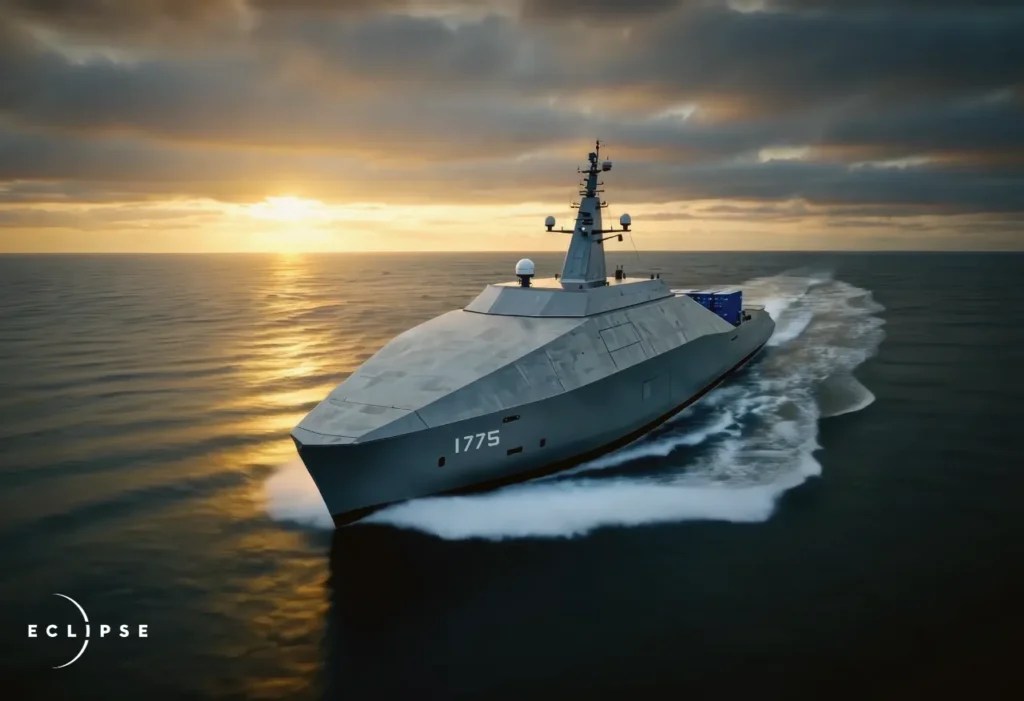As the U.S. Navy faces rising global threats and urgent capability gaps, a new generation of founders is stepping in with hard-earned domain expertise and bold technical ambition. One of them is Rylan Hamilton — a Navy veteran and serial robotics entrepreneur — who’s building software-defined, modular ships designed for autonomy, flexibility, and scale. We sat down with Rylan to discuss his journey from the Persian Gulf to startup boardrooms, and how Blue Water Autonomy is reimagining the naval fleet from the keel up.
Eclipse: What led you from a Navy career into entrepreneurship?
Rylan: My path was definitely nonlinear. I joined the Navy after 9/11, driven by a love for the ocean and a sense of duty. I served as a surface warfare engineering officer, eventually becoming a navigator on a frigate in the Pacific. Those years taught me just how complex and maintenance-heavy naval ships are — and how critical reliability and teamwork are at sea. After the Navy, I worked in construction management, then pivoted to business school and ultimately into tech, starting with Vistaprint and later Kiva Systems (which became Amazon Robotics). That eventually led me to co-found 6 River Systems (acquired by Shopify in 2019), and now, Blue Water Autonomy.
Eclipse: How did Blue Water Autonomy come together?
Rylan: It started with a conversation between myself and my now co-founder, Austin Gray, a Navy intel officer. We shared a belief that autonomous vessels could fundamentally reshape naval operations, but we didn’t jump in with a product in mind. We spent months doing deep customer research — talking to Navy contacts, understanding needs, mission gaps, and tech requirements. Eventually, we saw a clear opportunity to build smaller, autonomous ships that could be cost-effective, flexible, and resilient.

Eclipse: What exactly are you building?
Rylan: Think of it as the world’s largest mobile robot on water — a software-defined, modular surface vessel. It’s designed using commercial off-the-shelf components, like those used in robotics or supply chain automation, and integrated with software to operate independently in challenging marine conditions. It’s also built to be intuitive — like turning on an iPhone — because no roboticist will be onboard.

Eclipse: What unique advantages does your autonomous platform provide to the Navy?
Rylan: Two things: Modularity and software-defined operations. Because there’s no crew, we don’t need accommodations like galleys or living quarters. That opens up the design for interchangeable payloads. Our software architecture also means every component — from pumps to propulsion — can be monitored and updated remotely. Traditional warships are built once for decades. We’re building adaptable platforms for today’s evolving missions.
Eclipse: What makes autonomous ships a good fit for existing naval operations?
Rylan: Our ships won't replace destroyers or aircraft carriers, but will complement them. Our ships act like pawns on a chessboard: They go first, gather intelligence, extend the Navy's reach, and absorb risk. In regions like the Red Sea or near Taiwan, where asymmetric threats like drones and missiles are rising, these unmanned vessels can help protect high-value crewed ships from harm.
Eclipse: What challenges come with building ships like this?
Rylan: Everything from parts sourcing to weatherproofing to supply chain logistics. These aren’t drones — you can’t iterate weekly. We’re solving for extreme environments, autonomous endurance, and trust from the Navy. Our maritime supply chain isn’t optimized for speed, so we’re being scrappy by finding thrusters and engines in warehouses around the world. But we’re building for scale, too. Eventually, these ships can be built in months, not years.
Eclipse: How has your Navy experience shaped Blue Water Autonomy?
Rylan: It’s central. Without that background, I wouldn’t understand the Navy’s needs, its operational realities, or its culture. It also gives us credibility. The Navy doesn’t just want cool tech — they want trusted partners who understand what it’s like to refuel at sea or land a helicopter in rough waters. That lived experience translates directly into better product design, customer alignment, and ultimately, mission impact.

Eclipse: You first worked with the Eclipse team when you co-founded 6 River Systems. What made you want to work with us again when you founded Blue Water?
Rylan: I went back to Eclipse for the first check because you understand how to build full-stack companies and have the patience to see them through. For founders who want a partner that combines long-term commitment with the ability to accelerate momentum, Eclipse is hard to beat.
Eclipse: Tell us more about the team you are building at Blue Water.
Rylan: We’re building a mission-driven team. Several of us are veterans, including Navy intel and special forces. We all share a commitment to problem-solving, grit, and working under pressure. It’s not about prestige — it’s about being in it together. That sense of shared purpose is what makes a startup thrive, especially when you’re tackling hard technical and national security challenges.
Follow Eclipse on LinkedIn or sign up for Eclipse’s Newsletter for the latest on building the New Economy




